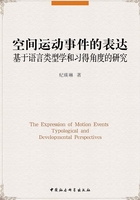
1.3 THE STUDY OF SPACE IN CHINESE
The two languages we have selected for comparison in this study are English and Chinese.The former has been thoroughly explored both in the domain of motion event typology and that of language development.English is commonly held as a representative satellite-framed language against which the degree of the satellite-framedness of a given language is usually determined.Furthermore, English children's acquisition of the expression of motion events has been widely investigated in different contexts of motion, showing their developmental progression from the use of path particles alone to a combination of path particles and manner verbs.In stark contrast, very few systematic studies have been conducted on Chinese either with regard to its typological properties or with regard to Chinese children's acquisition of motion expressions.For instance, Chen (2005) and Slobin (2004) have systematically explored the typological classification of Chinese with regard to motion expressions.Both drew data from only one database, Slobin's Frog story,and might therefore not be fully generalizable.Further, these two researchers looked into only one type of motion event, namely, self-initiated voluntary motion.The way in which the Cause component could be incorporated into the basic motion schema and its influence on the overall typological pattern of Chinese were not touched upon in these works.Thus, the typological investigation of Chinese greatly needs a more extensive study based on a larger data set.
Developmental research concerning Chinese children's acquisition of motion expressions has three noteworthy characteristics.First, previous studies are almost exclusively concerned with static situations (Fang 1999, Qi 1998, P.Li, Unp.Ms.); in particular, very little research has focused on the expression of motion during development, particularly motion involving changes of location.Second, earlier literature is characterized by a focus on locative prepositions in Chinese.It concentrates on diachronic development and acquisition of Chinese locative terms (see, for instance, Cui 2002, Fang 1999, Qi 1998) and more specifically on pragmatic factors governing the operational mechanism of the locative system in Chinese (P.Li, Unp.Ms.).Other grammatical devices contributing to the expression of motion events such as the verb (e.g.tiao 2 ‘to jump’, guo 4 ‘to cross’), the subordinated clause carrying spatial information (i.e.the ZHE clause in the ZHE construction), the noun (e.g.hua 2xue 3zhe 3 ‘the skater’) and certain onomatopoeia (e.g.ceng 1ceng 1-de ‘swiftly’) are simply neglected.Furthermore, the expression of motion through use of a Path verb alone and its relationship to the syntactic complexity and the event structure of an utterance has never been examined before.
A third characteristic of previous research is that relevant developmental studies in Chinese tend to focus on the order of emergence and error patterns in the use of spatial terms by Chinese children during development; they are not comparative studies and not concerned with universal versus language-specific influences on acquisition.The few available comparative studies mainly investigate the ‘aligned’ versus the ‘facing’ strategy in spatial reference, and the comparison is normally conducted between Chinese and another non Indo-European language such as Japanese (e.g.Fang 1987, P.Li 1990).